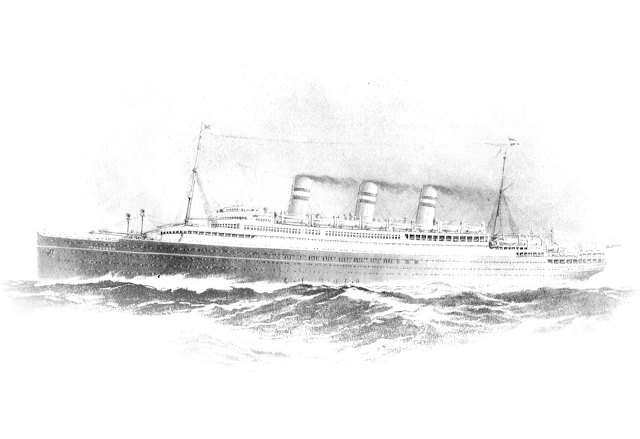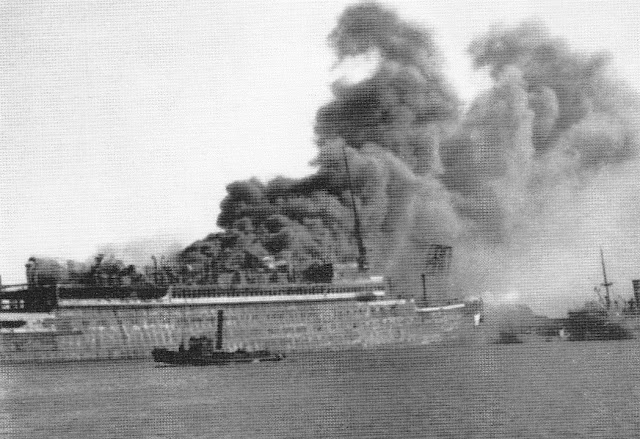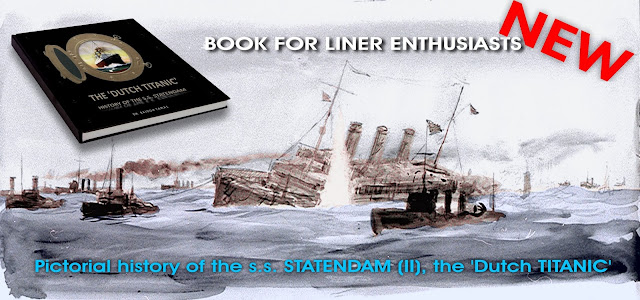The "
Dutch TITANIC", laid down 1912 as STATENDAM, seized by the British Royal Navy to become the trooper
JUSTICIA. A new book by historian Tamás Balogh is the first compendium about that liner, that never saw civil service, and was lost during WWI.
While TITANIC is ostentatiously called the most luxurious liner, STATENDAM offered luxury features that recalled the grandness of lounges and luxuries of the German Ballin trio - e.g. a Main Lounge two decks high, between the first and second funnel, a two deck high Dining Room, as well a Wintergarden of one and a half deck hight.
OLYMPIC Class only offered one deck high salons ...
by Earl of Cruise
 |
| b/w copy from a painting of the intended STATENDAM, the second in the
fleet of HOLLAND AMERICA LINE - courtesy Peter Meersman, collector of
the original painting |
The first
STATENDAM (10,322 GT) was constructed and inaugurated in 1898 and had been sold to ALLAN LINE in 1911.
When STATENDAM II was laid down in Belfast at HARLAND & WOLFF the Dutch liner was the nineth largest liner in the world with 32,234 GT (
IMPERATOR laid down
1910 - 52,117 GT, AQUITANIA laid down 1910 - 45,647 GT, LUSITANIA -
31,938 GT, TITANIC laid down 1909 - 46.329, BRITANNIC laid down 1911 -
48,158 GT, VATERLAND laid down 1911 - 54,282 GT, COLUMBUS/HOMERIC laid down 1912 - 34,351 GT and BISMARCK laid down 1913 -
56,551 GT).
Dutch Transatlantic passenger transport means
HOLLAND AMERICA LINE (NEDERLANDSCHE-AMERIKAANSCHE STOOMVAART MAATSCHAPPIJ) based in Rotterdam. The quality of the company's services is characterized by the fact that its vessels known as "
the spotless fleet".
The most prestigious ocean liner of this fleet would have been STATENDAM. Her building was started in 1914 and finished in 1917. She is still the largest Dutch passenger vessel, the "
Dutch TITANIC". And not just because of her size. Her story linked with the fate of the unfortunate British liner, and had the same tragic end. Her plans were inspired by the plans of TITANIC's older sistership, OLYMPIC, and her hull built exactly on the same slipway - at HARLAND & WOLFF SHIPYARD in Belfast - where the TITANIC was built a year earlier, while shipbuilders were working on TITANIC's younger sister, GIGANTIC (later renamed BRITANNIC) on the neighboring slipway.
 |
| STATENDAM II with her Edwardian Styled interior - © Dr. Tamás Balogh |
 |
| Schematic longitudunal cut of Statendam - © Dr. Tamás Balogh |
The first disturbing event of the ship’s story occurred almost immediately after the order of her building - in 1912 - when his „father” and mastermind, the director of HOLLAND AMERICA LINE, Johan Georg Reuchlin, lost his life on board of the TITANIC.
The disquieting circumstances, however, have grown since WWI broke out just nine days after the liner was launched. The outfit of the liner slowed down and temporarily stopped as the shipbuilder started to complete naval orders, and STATENDAM was completed, just after the sinking of the LUSITANIA, in order to replace the lost cargo capacity. The British government then hired (
which is the official wording) the Dutch giant on condition that she would return to her original owners at the end of the war. Or if this was not possible due to the devastation of the ship, another vessel would be build for HOLLAND AMERICA LINE in same dimensions. Discretely it was planned that STATENDAM should stay with the first managing company CUNARD.
 |
| STATENDAM II in war dazzle paint as JUSTICIA - Source: Wikipedia |
CUNARD was unable providing a crew for JUSTICIA (the vessel was named that way to fit in the nomenclatur of CUNARD), so the liner went to WHITE STAR LINES, they had a "free" crew from the sunken BRITANNIC.
 |
| STATENDAM II, hmts JUSTICIA sailing during war duties - Source: Ouddorp.de |
STATENDAM - now called
JUSTICIA - has become one of the protagonists of the military service from America to Europe. On its four transatlantic routes, she delivered around 20,000 soldiers, 12,000 civilian personnel and thousands of tonnes of military equipment. In December 1917, she overthrew the record of the wartime naval tansport, when she transported 30,000 tonnes of munitions on a single journey. Just four months before the end of the war, the end came when one of the torpedoes of the submarine U 64 hit her side on 19th of July, 1918.
However, the oceanliner did not sink, using the navy's tugboat to reach a coast in Ireland. Twenty-four hours long and epic fight began with the flooding water and the enemy, in which the ship's gunners made several torpedoes exploded or hijacked by some ecxellent shots. Finally the U 54 and U 124 submarines – alerted by the U 64 – finished ont he next day what the U 64 started earlier. It was the longest-running duell between a liner and submarines during the entire war, and Justicia was the second largest merchant ship sinking in the First World War, followed by BRITANNIC which was obviously hit by a German mine in 1916. Special story of the ship does not end there!
The British Government has fulfilled its contractual obligations and provided 60,000 tonnes of steel to HOLLAND AMERICA LINE in 1919 to compensate the company for the loss. By this compensation, the company ordered a new ocean liner at HARLAND & WOLFF SHIPYARD, which was completed in 1929. The third STATENDAM III was laid down in 1921. Construction on this replacement, the
third STATENDAM
, began in 1921 but took longer
than intended and became more expensive
due to changes in American emigration
laws. This forced HOLLAND AMERICA LINE to have her emmigration quarters, converted
into
more comfortable cabins for the tourist trade
and cruising.
 |
| STATENDAM III being launched at HARLAND & WOLFF 1924 - courtesy relevantsearchscotland.co.uk |
After being launched in
1924, HOLLAND AMERICA LINE had to put work
on her completion on hold as they had
encountered financial difficulties.
Further HARLAND & WOLFF had slowed significantly the construction on the newbuilding.
 |
| STATENDAM III nearing completition at WILTON FIJENOORD - courtesy relevantsearchscotland.co.uk |
Assistance from the Dutch Government in
1927 allowed the hull of STATENDAM
to be towed to Schiedam in the Netherlands for
completion by
WILTON FIJENOORD. This new ship was also named STATENDAM and her general appearance was generally similar to her predecessor. It seemed that HOLLAND AMERICA LINE's development - which interrupted during the First World War - could be continued, as the new vessel had redeemed her hopes and became one of the most popular vessel in the North-Atlantic. Her destiny came with the World War II when she was burned out in 1940 during the siege of Rotterdam. Her remains were dismantled shortly afterwards. The service of the two STATENDAM is essentially a single 30-years long story in which the excellence and the persistence gave enough power to the HOLLAND AMERICA LINE for trying to come true it’s dreams.
 |
| 14 May 1940 STATENDAM III on fire rpvided - courtesy by Willem van der Leek |
 |
| Burned STATENDAM III - courtesy relevantsearchscotland.co.uk |
Today, the wreck of STATENDAM lies on the ocean floor (45 km / 28 mi north-west of
Malin Head,
Ireland in waters 68 metres / 223 ft deep) - swept by waves of the Atlantic Ocean - reminds us of this story, and this book, which collected it’s memories for the first time in the last hundred years.
You are looking for a special book? You got it!
 |
| The "Dutch TITANIC" a pictoral history, advertisinf - © Dr. Tamás Balogh |
Pictures of the most
important collectors, which have never been published yet about the s.s.
STATENDAM (II) ocean liner, the "Dutch TITANIC", which operated between
1914-1918. Detailed and important information, contemporary reports and
the results of the wreck-diving expeditions help to explore the
complete history of the famous ocean liner which has never been fully
presented in the last hundred years since her sinking. The 160 pages
volume illustrated with 210 images costs $ 32 + shipping costs all over
the world. The book is not available in bookstores. Those who are
interested in the book will support the publication of the great
pictorial enciclopedia of the Liners, illustrated with profile drawings.
Pre-orders are received in a private message.
Further information on the book:
https://www.facebook.com/notes/150-liners-by-thomas-balogh/the-dutch-titanic/791251951071362/
https://www.facebook.com/150liners/posts/791256471070910?hc_location=ufi
Sample pages:
https://drive.google.com/…/1GKet5JQD3-5AJu3hOIfmXvR09…/view…
 |
| Copied pages from the new book, in Hungarian - © Dr. Tamás Balogh |
About the book:
The book contains 160 pages, 150 132 characters (without spaces), 8 chapters and 210 images. Four famous private collectors of those two countries (the Netherlands and Ireland), which has strong connection to the liner’s story supported the work with a number of photographs that had never been published before. They trusted a maritime historian came from a small landlocked coutry that once was a part in seafaring nations - Hungary, and decided to show this unique story for the first time on the centenary of the events in an independent volume.
Divers who searched the wrekcs provided their underwater photographs for the volume, which provided a unique opportunity to present a detailed picture of the ship's remnants.
This volume represents a story of a famous ocean liner which has not yet been fully and deservingly presented until now: "
Splendid book. This is the first time I see an owerview of her ... I'm pleased to give this forgotten ship finally some attention."- Peter Meersman "
Brilliant. The ship had an international appeal and an obvious interest among enthusiasts."- Campbell McCutcheon. According to the author’s intentions the volume will be presented on 20th of July, 2018 at the centenary of the ship’s sinking.








Comments
Post a Comment